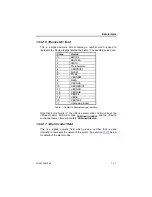
CBU-NM
User Manual
ii 80-60100000-02
11–2
If the link is not working, check the port connections and the settings in
PCNC.INI’s [Remote Link] or [SNMP Link] section.
11.3 Some alerts are not being processed
When many alerts are sent to PCNC over a short period of time, PCNC’s
receive buffer can overflow, and alert information is lost. To overcome
this, PCNC provides a ‘Handshaking’ facility, which can control the flow
of alerts from a Cabletron network. This facility can be turned on or off
with a setting in PCNC.INI (see Section
7.8.5
)
Handshaking requires a ‘straight through’ cable to be used between
PCNC and the network, as specified in Section
14.3.2
. If a ‘looped’
cable is used, it will be possible to communicate with devices correctly,
but PCNC will be unable to control the flow of alert information.
Due to the nature of the network, handshaking cannot operate correctly
when a device is being polled by the Control Terminal. It is therefore
important that connections to polled devices are not left open at times of
heavy network traffic. See Section
14.5
for more details.
11.4 The command line is not working properly
If the command line appears in the Control Terminal window, but
behaves strangely, it is likely you are using a handshaking cable with
handshaking disabled.
With handshaking disabled, a ‘looped’ cable is required. If a ‘straight
through’ cable is used, it will not be possible to select devices correctly.
When you attempt to poll a device, its command-line prompt will not
appear. When you attempt to poll a different device, PCNC will display
any prompts or messages generated by the first device during the time it
was polled. The command-line interface will be erratic, and you will be
unlikely to be able to use it. To correct the problem, either enable
handshaking (see Section
7.8.5
) or use a looped cable as specified in
Section
14.3.1
.
11.5 You set a filter, but the alarm still appears
If a certain alarm should have been hidden by the filters you have set,
but still appears in the Alarm Log windows, then it is probably an
Unrecognised Alert alarm. This type of alarm is generated when
device type specified in the Network Database is inconsistent with the
















































